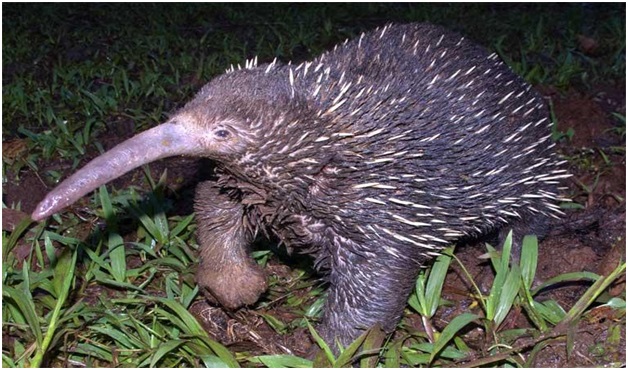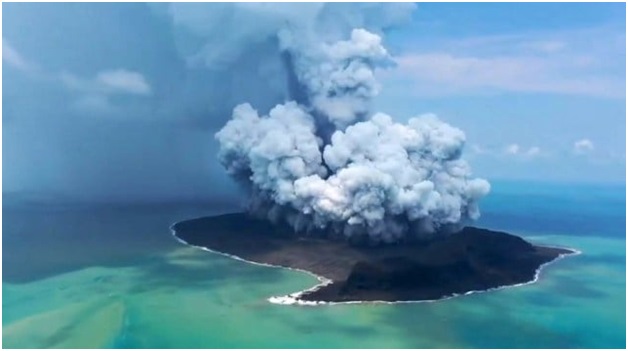Attenborough's Long-beaked Echidna (The Hindu)

- 11 Nov 2023
Why in the News?
An elusive echidna feared extinct after disappearing for six decades has been rediscovered in a remote part of Indonesia, on an expedition that also found a new kind of tree-dwelling shrimp.
About Attenborough's long-beaked echidna:
- Attenborough's long-beaked echidna (Zaglossus attenboroughi), also known as Sir David's long-beaked echidna or the Cyclops long-beaked echidna.
- It is an egg-laying mammal native to the Cyclops Mountains in the northern Indonesian region of Papua.
- It is one of three species of long-beaked echidna, and is the smallest and most threatened of the three.
- The echidna was named after naturalist Sir David Attenborough.
- The echidna is a nocturnal animal, and it is most active at night.
- It spends its days sleeping in burrows, and it emerges at night to forage for food.
- The echidna's diet consists of ants, termites, beetles, and other insects.
- Attenborough's long-beaked echidna is classified as Critically Endangered by the IUCN.
5th Annual India- US ‘2+2’ Dialogue (The Hindu)

- 11 Nov 2023
Why in the News?
India and the U.S. on November 10 held extensive deliberations to further expand their global strategic partnership through greater defence industrial ties, enhancing engagement in the Indo-Pacific and boosting cooperation in key areas such as critical minerals and high technology.
Context:
- The fifth annual ‘2+2’ dialogue between India and the United States is underway in New Delhi.
- The U.S. delegation at the 2+2 ministerial talks was led by U.S. Secretary of State Antony Blinken and U.S. Defence Secretary Lloyd Austin.
- External Affairs Minister S Jaishankar and Defence Minister Rajnath Singh headed the Indian side.
What is the 2+2 Dialogue?
- The 2+2 Ministerial Dialogue, an annual diplomatic summit being held since 2018, brings together India's foreign and defence ministers with their US counterparts.
- Its purpose is to address and collaborate on common concerns to enhance and strengthen India–United States relations.
- A 2+2 ministerial dialogue enables the partners to better understand and appreciate each other’s strategic concerns and sensitivities taking into account political factors on both sides, in order to build a stronger, more integrated strategic relationship in a rapidly changing global environment.
- India has 2+2 dialogues with four key strategic partners: the US, Australia, Japan, and Russia.
- Besides Russia, the other three countries are also India’s partners in the Quad.
- The US is India’s oldest and most important 2+2 talks partner.
Cell Broadcast Alert System (CBAS) (The Hindu)

- 11 Nov 2023
Why in the News?
The Cell Broadcast Alert System (CBAS) of the National Disaster Management Authority (NDMA) did not effectively disseminate mass alerts during natural disasters, despite recent testing.
About Cell Broadcast Alert System (CBAS):
- The Cell Broadcast Alert System (CBAS) is a public warning system that uses mobile networks to send emergency alerts to mobile phones within a specific geographic area.
- It is a one-way messaging system that allows authorized authorities to send short messages to all mobile phones within a designated area, regardless of whether the recipients are subscribed to the mobile network or not.
Benefits of CBAS:
- Rapid and widespread dissemination of information: CBAS can reach a large number of people within a short period of time, making it an effective tool for communicating critical information during emergencies.
- No user interaction required: CBAS messages are automatically displayed on mobile phones, so there is no need for users to take any action to receive them.
- Effective for reaching all mobile phone users: CBAS messages can be received by all mobile phone users, regardless of whether they are subscribed to a particular mobile network or not.
- Not affected by network congestion: CBAS messages are not affected by network congestion, so they can be delivered even when network traffic is heavy.
CBAS can be used to send a variety of emergency alerts, including:
- Weather warnings: CBAS can be used to warn people of impending severe weather, such as tornadoes, hurricanes, and flash floods.
- Amber Alerts: CBAS can be used to broadcast information about missing children.
- Public safety alerts: CBAS can be used to warn people of other public safety threats, such as fires, terrorist attacks, and chemical spills.
Phreatomagmatic Eruptions (TOI)

- 11 Nov 2023
Why in the News?
Recently a new island emerged near Japan's Ogasawara island chain after an undersea volcano erupted.
What is Phreatomagmatic Eruption?
- A phreatomagmatic eruption is a volcanic eruption caused by the interaction of magma and water.
- They differ exclusively from magmatic and phreatic eruptions.
- Unlike phreatic eruptions, the products of phreatomagmatic eruptions contain juvenile (magmatic) debris.
- Large explosive eruptions typically contain magmatic and phreatomagmatic components.
- Phreatomagmatic ash is formed by the same mechanism over a wide range of basic and acidic compositions.
- A blocky and uniform crust with low vesicle content is formed.
- Deposits from phreatomagmatic eruptions are thought to be better classified and finer-grained than those from magmatic eruptions.
- This is the result of higher fragmentation of phreatomagmatic eruptions.
About Ogasawara Islands:
- The Ogasawara Islands are a group of more than 30 small subtropical islands in the North-Western Pacific Ocean roughly 1,000 km south of the main Japanese Archipelago.
- It is also known as the Bonin Islands.
- It is one of the famous UNESCO World Heritage sites of Japan.
Vampire Viruses (TOI)

- 11 Nov 2023
Why in the News?
For the first time, several ‘vampire viruses have been detected in the soil samples in the USA recently.
About Vampire Viruses:
- "Vampire viruses", also known as virophages, are viruses that parasitize other viruses.
- They have been known to science for decades, but this is the first time they have been discovered in the United States.
- The viruses were found in soil samples from Maryland and Missouri.
- Virophages are thought to attach themselves to other viruses and inject their own genetic material into the host-virus.
- This genetic material then takes over the host virus's replication machinery, allowing the virophage to reproduce itself.
- The host-virus is eventually destroyed in the process.
- Virophages could be used to control harmful viruses that infect crops or livestock.
- They could also be used to design new antiviral drugs that target viruses in a more specific way than current drugs.
- However, the discovery of virophages also raises some concerns.
- Virophages could potentially kill beneficial viruses that play an important role in the environment.
- For example, some viruses help to break down organic matter in soil, while others help to control populations of harmful bacteria.
